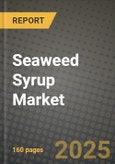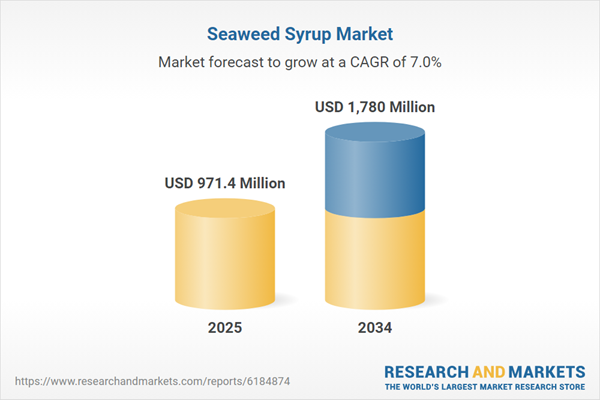Seaweed Syrup Market
The seaweed syrup market is emerging at the intersection of clean-label nutrition, ocean-based sustainability, and culinary innovation. Derived primarily from brown and red macroalgae through gentle extraction and concentration, seaweed syrup offers a naturally derived sweet-savoury profile with functional benefits linked to minerals, polyphenols, and prebiotic fibres. Top applications include beverages (functional shots, kombucha-style ferments), bakery and confectionery (natural colour and umami lift), sauces and condiments (glaze, marinades), dairy alternatives (plant-based yoghurts and frozen desserts), and nutraceutical formats where viscosity and mineral content are valued. Latest trends feature regenerative ocean farming, traceable supply chains, organic and allergen-free claims, and chef-led flavour development that blends sweet, saline, and umami notes. Driving factors span the shift away from synthetic additives, demand for novel plant-based ingredients, and brand storytelling around carbon-smart, low-input crops. The competitive landscape includes coastal aquaculture specialists scaling vertically from farm to finished syrup, ingredient majors partnering for co-development, and niche D2C brands emphasizing terroir, varieties, and culinary narratives. Companies differentiate via algae species selection, contaminant controls, flavour standardization, and processing know-how such as low-temperature concentration, membrane filtration, and enzymatic hydrolysis that preserve bioactives and reduce off-notes. Procurement teams increasingly evaluate suppliers on year-round supply security, third-party certifications, and data-backed sustainability metrics. As regulatory clarity improves on algae-derived ingredients in mainstream categories, seaweed syrup is set to broaden from culinary niche to functional staple, with hybrid formulations (e.g., seaweed + fruit syrups) and customizable mineral profiles expanding addressable use-cases.Seaweed Syrup Market Key Insights
- niche garnish to functional base. Product developers now treat seaweed syrup as a primary flavour/functional input rather than a garnish, leveraging umami-sweet synergy to reduce added sugars and boost mineral positioning across beverages, sauces, and plant-based dairy.149
- Regenerative aquaculture as a growth catalyst. Low fertiliser needs and potential ecosystem benefits make kelp and other macroalgae attractive to ESG-minded brands; audited, traceable farms strengthen claims and de-risk retailer acceptance in premium aisles.
- Species and terroir matter. Brown species support robust umami and mineral notes, while select red seaweeds deliver colour and milder sweetness - blending and seasonal sourcing help standardize taste and viscosity across batches.
- Processing drives consistency. Low-temperature evaporation, membrane filtration, and enzymatic pre-treatment improve flavour clarity and shelf stability, while advanced deodourisation addresses marine notes for mainstream palates.
- Clean-label and allergen-free positioning. Vegan, gluten-free, and often kosher/halal certifications expand penetration in better-for-you segments; simplified ingredient decks support front-of-pack claims without synthetic additives.
- Hybrid syrups for flavour architecture. Combining seaweed concentrates with fruit, malt, or coconut syrups balances sweetness and salinity, enabling category-specific targets from cocktail mixes to dessert toppings.
- Safety and compliance as table stakes. Robust heavy-metal, iodine, and microbiological controls - plus region-specific labelling guidance - are mandatory for multinational launches and infant/clinical-adjacent explorations.
- Supply-chain smoothing through vertical integration. Farm-to-finish models and multi-site harvesting mitigate seasonal variability, while inventory plans and frozen/intermediate concentrates ensure year-round formulation continuity.
- Culinary co-creation accelerates adoption. Partnerships with chefs and mixologists generate signature flavours and limited editions, building consumer familiarity and premium price realisation.
- Education-led marketing wins. Clear messaging on taste, usage, and sustainability science - backed by QR-enabled traceability - reduces trial barriers and supports repeat purchases in both B2B and D2C channels.
Seaweed Syrup Market Reginal Analysis
North America
Innovation is propelled by natural foods, specialty retail, and foodservice experimentation. Brands highlight regenerative ocean farming on Atlantic and Pacific coasts, with strong buyer interest in clean-label sweeteners for beverages and alt-dairy. Regulatory diligence on contaminants and transparent iodine disclosures are key for national chains. Partnerships between aquaculture start-ups and ingredient majors help scale supply, while chef collaborations popularize flavour-forward applications.Europe
Sustainability frameworks and retailer standards favour traceable, low-impact ingredients, positioning seaweed syrup as a fit for eco-conscious private labels. Northern Atlantic harvesting and controlled aquaculture supply culinary and nutraceutical channels alike. Strict specifications on contaminants and compositional consistency drive investment in analytics and standardized processing. Culinary traditions embracing umami and fermented profiles support use in sauces, pickles, and artisanal bakery.Asia-Pacific
Long-standing seaweed cultivation expertise underpins reliable raw material access, with Japan, Korea, and parts of China leading on species know-how and processing. Emerging beverage and dessert formats incorporate seaweed syrup for functional halo and flavour depth. Southeast Asia leverages coastal farming potential, while Australia/New Zealand emphasize premium, traceable origin stories. Regional R&D focuses on flavour refinement and hybrid syrups for mainstream palates.Middle East & Africa
Premium hospitality and health-oriented retail adopt seaweed syrup for mixology, gourmet sauces, and functional beverages. Import-reliant supply favours partners offering turnkey quality assurance and shelf-stable formats. Coastal pilot farms and collaborations with international processors are explored to localize value chains. Halal certification, clean-label claims, and heat-stable formulations are important in hot-climate distribution.South & Central America
Culinary diversity and growing interest in sustainable coastal economies support trials in sauces, ceviche-style condiments, and beverage mixers. Partnerships with coastal communities and universities explore pilot aquaculture to reduce reliance on imports. Retailers seek differentiated natural sweetener options with strong provenance stories. Compliance with local additive rules and education on usage help build awareness beyond niche health stores.Seaweed Syrup Market Segmentation
By Product
- Brown seaweed
- Red seaweed
- Green seaweed
By Application
- Agriculture
- Animal Feed
- Human Consumption
- Others
Key Market players
CP Kelco (Tate & Lyle), Gelymar S.A., Algaia S.A., KIMICA Corporation, CEAMSA (Compañía Española de Algas Marinas), W Hydrocolloids, Inc., Hispanagar S.A., Arthur Branwell & Co. Ltd., Qingdao Bright Moon Seaweed Group Co., Ltd., Shemberg Group, Marine Hydrocolloids (Meron), Greenfresh Group (Fujian Greenfresh Foods), DuPont (IFF) - Danisco, The Seaweed Company, Ocean’s Balance.Seaweed Syrup Market Analytics
The report employs rigorous tools, including Porter’s Five Forces, value chain mapping, and scenario-based modelling, to assess supply-demand dynamics. Cross-sector influences from parent, derived, and substitute markets are evaluated to identify risks and opportunities. Trade and pricing analytics provide an up-to-date view of international flows, including leading exporters, importers, and regional price trends.Macroeconomic indicators, policy frameworks such as carbon pricing and energy security strategies, and evolving consumer behaviour are considered in forecasting scenarios. Recent deal flows, partnerships, and technology innovations are incorporated to assess their impact on future market performance.
Seaweed Syrup Market Competitive Intelligence
The competitive landscape is mapped through proprietary frameworks, profiling leading companies with details on business models, product portfolios, financial performance, and strategic initiatives. Key developments such as mergers & acquisitions, technology collaborations, investment inflows, and regional expansions are analyzed for their competitive impact. The report also identifies emerging players and innovative startups contributing to market disruption.Regional insights highlight the most promising investment destinations, regulatory landscapes, and evolving partnerships across energy and industrial corridors.
Countries Covered
- North America - Seaweed Syrup market data and outlook to 2034
- United States
- Canada
- Mexico
- Europe - Seaweed Syrup market data and outlook to 2034
- Germany
- United Kingdom
- France
- Italy
- Spain
- BeNeLux
- Russia
- Sweden
- Asia-Pacific - Seaweed Syrup market data and outlook to 2034
- China
- Japan
- India
- South Korea
- Australia
- Indonesia
- Malaysia
- Vietnam
- Middle East and Africa - Seaweed Syrup market data and outlook to 2034
- Saudi Arabia
- South Africa
- Iran
- UAE
- Egypt
- South and Central America - Seaweed Syrup market data and outlook to 2034
- Brazil
- Argentina
- Chile
- Peru
Research Methodology
This study combines primary inputs from industry experts across the Seaweed Syrup value chain with secondary data from associations, government publications, trade databases, and company disclosures. Proprietary modeling techniques, including data triangulation, statistical correlation, and scenario planning, are applied to deliver reliable market sizing and forecasting.Key Questions Addressed
- What is the current and forecast market size of the Seaweed Syrup industry at global, regional, and country levels?
- Which types, applications, and technologies present the highest growth potential?
- How are supply chains adapting to geopolitical and economic shocks?
- What role do policy frameworks, trade flows, and sustainability targets play in shaping demand?
- Who are the leading players, and how are their strategies evolving in the face of global uncertainty?
- Which regional “hotspots” and customer segments will outpace the market, and what go-to-market and partnership models best support entry and expansion?
- Where are the most investable opportunities - across technology roadmaps, sustainability-linked innovation, and M&A - and what is the best segment to invest over the next 3-5 years?
Your Key Takeaways from the Seaweed Syrup Market Report
- Global Seaweed Syrup market size and growth projections (CAGR), 2024-2034
- Impact of Russia-Ukraine, Israel-Palestine, and Hamas conflicts on Seaweed Syrup trade, costs, and supply chains
- Seaweed Syrup market size, share, and outlook across 5 regions and 27 countries, 2023-2034
- Seaweed Syrup market size, CAGR, and market share of key products, applications, and end-user verticals, 2023-2034
- Short- and long-term Seaweed Syrup market trends, drivers, restraints, and opportunities
- Porter’s Five Forces analysis, technological developments, and Seaweed Syrup supply chain analysis
- Seaweed Syrup trade analysis, Seaweed Syrup market price analysis, and Seaweed Syrup supply/demand dynamics
- Profiles of 5 leading companies - overview, key strategies, financials, and products
- Latest Seaweed Syrup market news and developments
Additional Support
With the purchase of this report, you will receive:- An updated PDF report and an MS Excel data workbook containing all market tables and figures for easy analysis.
- 7-day post-sale analyst support for clarifications and in-scope supplementary data, ensuring the deliverable aligns precisely with your requirements.
- Complimentary report update to incorporate the latest available data and the impact of recent market developments.
This product will be delivered within 1-3 business days.
Table of Contents
Companies Mentioned
- CP Kelco (Tate & Lyle)
- Gelymar S.A.
- Algaia S.A.
- KIMICA Corporation
- CEAMSA (Compañía Española de Algas Marinas)
- W Hydrocolloids Inc.
- Hispanagar S.A.
- Arthur Branwell & Co. Ltd.
- Qingdao Bright Moon Seaweed Group Co. Ltd.
- Shemberg Group
- Marine Hydrocolloids (Meron)
- Greenfresh Group (Fujian Greenfresh Foods)
- DuPont (IFF) – Danisco
- The Seaweed Company
- Ocean’s Balance.
Table Information
| Report Attribute | Details |
|---|---|
| No. of Pages | 160 |
| Published | November 2025 |
| Forecast Period | 2025 - 2034 |
| Estimated Market Value ( USD | $ 971.4 Million |
| Forecasted Market Value ( USD | $ 1780 Million |
| Compound Annual Growth Rate | 7.0% |
| Regions Covered | Global |
| No. of Companies Mentioned | 15 |









